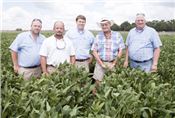|
Soybean Booster
 James Oliver, owner and president of Raymat Crop Science, discussed James Oliver, owner and president of Raymat Crop Science, discussed
the benefits of the technical ingredient, Diflubenzuron, in Cavalier 2L Insect Growth
at a plot tour recently on his Deer Creek farm at Stoneville, Miss.
Pictured from left to right are MSU Dr. Bobby Golden; Jason Fratesi, Southern Ag Consulting;
Jason Cotton, Helena; James Oliver, Raymat Crop Science; and Alan Blaine, Southern Ag Consulting.
Photo by John LaRose, Jr.
Cavalier 2L Insect Growth Regulator Can Reduce Costs, Prop Yields
BETTY VALLE GEGG-NAEGER
MidAmerica Farmer Grower
James Oliver, owner and president of Raymat Crop Science, discussed the benefits of the technical ingredient, Diflubenzuron, in Cavalier 2L Insect Growth regulator at a plot tour recently on his Deer Creek farm at Stoneville, Miss.
“We’ve been demonstrating on our own family farm for three years now that we can successfully grow our soybeans by protecting our beneficial insects and using our insect growth regulator in season,” he said. “We’ve been using Quadris Top at about 8 ounces per acre at R3, R4 stage and we’re including full rates of Cavalier 2L to protect our soybeans during the critical time of the year from July 20 to Aug. 20. For three years now we’ve been able to grow really good yields of soybeans on our farms without late season insecticide applications simply by relying on our beneficial insects, protecting them and utilizing Cavalier 2L insect growth regulator.”
Besides that, a cost savings and yield increase were also recorded.
“Cavalier 2L will always give you a yield increase, especially if you use it in combination with a good soybean fungicide that protects your fields,” Oliver said. “If you do not have to make a late season insecticide application, you’ll save from $20 to $25 per acre. We have approximately 3,000 acres of land and if we save that $25 an acre across our entire farm it makes a lot of difference on the profit and loss statement when the year ends.”
The take home message for using Cavalier 2L in soybeans is farmers should get those beans planted as early as possible.
“In this area we like to plant by April 15; that gets beans into a stage where our fungicide and Cavalier treatment will go out somewhere around July 15 to protect against our insects during the July 20 to Aug. 20 time frame,” Oliver said. “The other part is make sure you protect your beneficial insects. If your careful not to disturb your beneficial insects, keep your populations healthy and then use an insect growth regulator in lieu of hard pesticides, you may be able to achieve the same results that we have on our farms, and we’re very pleased.”
Recently, Oliver received the following soybean yield data from the Cavalier 2L tour plots:
Quadris Top alone – 64 bushels per acre (yields are rounded to nearest whole bushel)
Quadris Top + 4oz Cavalier 2L – 66 bushels per acre
Quadris Top + 6oz Cavalier 2L – 68 bushels per acre
Quadris Top + 8oz Cavalier 2L – 70 bushels per acre
All plot yields were harvested with the same combine.
In addition to harvesting high yields for the third straight year, Oliver did not have to make that expensive late season insecticide application. In fact, aside from the Cavalier 2L insect growth regulator application, no insecticide was applied to these plots.
These plots continue to reflect the trend previously seen of increased yields as the Cavalier 2L rate is increased.
The soils in these plots are consistent, except for the Quadris Top alone plot, where the soils are slightly mixed. However, according to the soils map, all plots are Sharkey Clay.
For more information about Cavalier 2L, check out the Raymat Crop Science website at www.Cavalier2L.com and read all about the product. The website provides the company information and you can download labels, MSDS sheets etc. ∆
BETTY VALLE GEGG-NAEGER: Senior Staff Writer, MidAmerica Farmer Grower
|
|